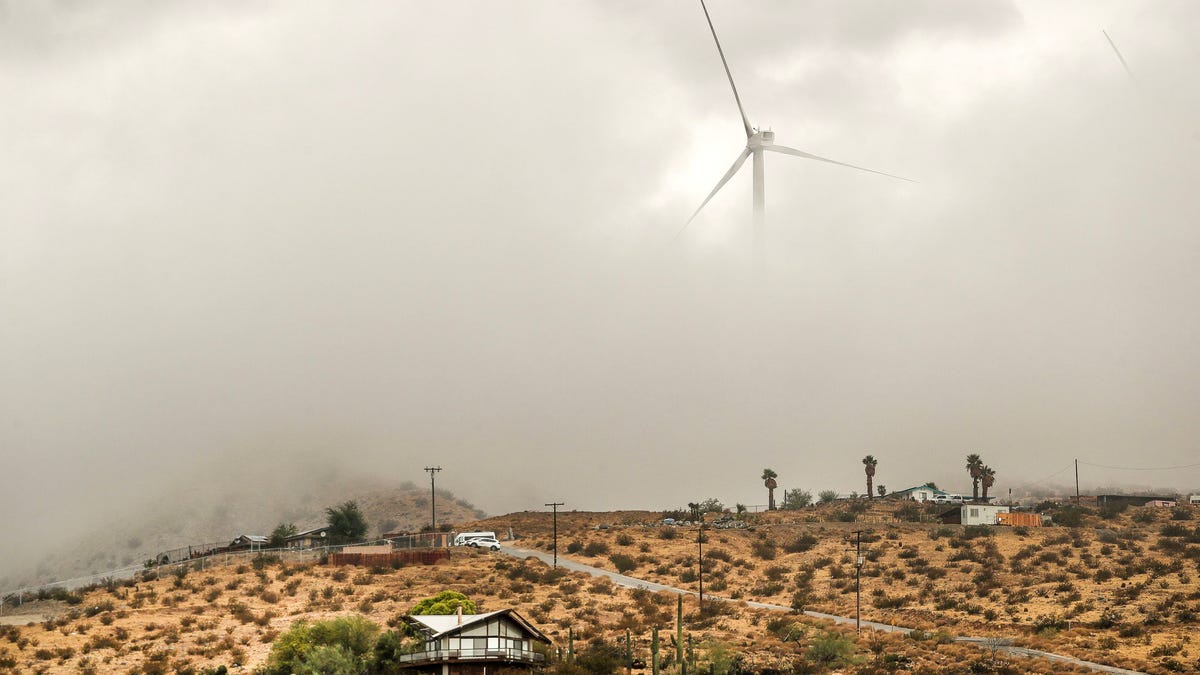Across America’s power grid, there’s a growing gap between what we need and what we’ll allow.
As the planet warms and climate disasters grow more costly, the U.S. has set a target to reach 100% clean energy by 2035, a goal that depends on building large-scale solar and wind power.
A nationwide analysis by USA TODAY shows local governments are banning green energy faster than they’re building it.
At least 15% of counties in the U.S. have effectively halted new utility-scale wind, solar, or both, USA TODAY found. These limits come through outright bans, moratoriums, construction impediments and other conditions that make green energy difficult to build.
The impediments come as a gigantic effort to build green energy also is under way. U.S. energy from commercial wind and solar is expected to hit 19% by 2025, and those sources are expected to surpass the amount of electricity made from coal this year.
But green energy must increase radically over the next 11 years to meet U.S. goals. And those projects are becoming harder to build.
In the past decade, about 180 counties got their first commercial wind-power project. But in the same period, more than twice as many blocked wind development. And while solar power has found more broad acceptance, 2023 was the first year to see almost as many individual counties block new solar projects as the ones adding their first project.
The result: Some of the nation’s areas with the best sources of wind and solar power have now been boxed out.
Opposition to large solar and wind farms grows in Kansas
One farm family hopes to see a solar energy plant built on their land. But in some places, efforts to build utility-scale solar and wind farms are met with fierce opposition.
Because large-scale solar and wind projects typically are built outside city limits, USA TODAY’s analysis focuses on restrictions by the county-level governments that have jurisdiction. In a few cases, such as Connecticut, Tennessee and Vermont, entire states have implemented near-statewide restrictions.
While 15% of America’s counties might sound like a small portion, the trend has significant consequences, says Jeff Danielson, a former four-term Iowa state senator now with the Clean Grid Alliance.
“It’s 15% of the most highly productive areas to develop wind and solar,” he said. “Our overall goals are going to be difficult to achieve if the answer is ‘No’ in county after county.”
The country’s green-energy deadline now sits just 11 years away. But even if politicians fail to meet that goal, another clock is ticking.
Last year, 2023, was the warmest in recorded history, warmer than any other in 125,000 years. And with the climate’s rising temperature comes rising risks: stronger hurricanes in the Atlantic, more severe cloudbursts in storms across the continent, increasing drought on the Great Plains, larger wildfires in the West.
Construction isn’t happening fast enough to meet the country’s green energy needs, said Grace Wu, a professor of energy resources at the University of California, Santa Barbara.
“I’m worried about what’s ahead,” she said.
The shift to green energy, and the rise of bans
The transition to green energy involves a profound national shift, a move from power plants that mostly burned coal, then natural gas, to new wind and solar installations. That also means shifting much of the nation’s energy generation to new regions, specifically the large wind belt down the middle of the country and the sunny southeast and southwest.
“Clean energy” includes other emissions-free sources such as nuclear (18%) and hydropower (6%). But both of those are controversial in their own right and unlikely to see major expansion in the U.S.
And sources such as rooftop solar panels on houses or businesses, while helpful, provide just a tiny fraction of the total power supply.
In the Northeast, several coastal states have instead made plans to rely on offshore wind turbines. But a wave of disinformation in 2023, falsely claiming offshore wind projects killed whales, resulted in a sharp decline in public support for offshore wind.
The only likely way to shift away from fossil fuels quickly is a sharp increase in solar and wind farms big enough to replace power plants, each one powering tens of thousands of homes.
The total amount of energy a solar plant can make varies widely based on size and location. The average-size solar plant today can power about 20,000 homes. A field of wind turbines can be similar, as each turbine can power about 1,000 homes.
The first large-scale wind farm in the U.S. started running nearly 50 years ago, in the aftermath of a global oil crisis. Built in Southern California, it powered more than 4,000 homes.
Wind power gained momentum in the early 2000s thanks to better technology and tax incentives.
But the number of new wind projects opening annually peaked in the early 2010s, according to inventory data from the U.S. Energy Information Administration, and has slowed since then.
Wind power is expected to grow 11% by 2025 from last year’s levels. In the past 10 years, 183 counties saw their first wind project come online. However, USA TODAY’s analysis found that in the same period, nearly 375 counties have essentially blocked new wind development. That’s almost as many as the 508 counties – out of 3,144 total in the U.S. – currently home to an operational wind turbine.
Utility-scale solar plants, using solar panels that have grown dramatically more efficient, have proliferated in the last decade. The U.S. added a record 33 gigawatts of solar power in 2023 and solar is expected to grow 75% by 2025. More than 1,000 counties now host solar farms.
“A solar panel in my part of Michigan produces 70% of the solar power the same panel in Phoenix, Arizona, does. Most people would expect the difference to be much bigger,” said Sarah Mills, a professor of urban planning at the University of Michigan who studies energy policy and land use.
However, opposition also has shot up, according to USA TODAY’s analysis. Of the 116 counties implementing bans or impediments to utility-scale solar plants, half did so in 2023 alone.
This surge in obstacles is unprecedented since green-energy technology gained broad acceptance.
“The local regulation landscape for renewables is changing quickly,” said Tamara Ogle, a member of the land use team at Purdue University Extension, who inventoried Indiana’s renewable energy ordinances in 2022.
Despite growing hostility, green energy can be an economic windfall in places that welcome it.
Much as places like Texas and Alaska grew rich when drilling companies struck oil, solar and wind power can bring in both construction work and cash, in the form of leases and tax revenue from the power plants.
“You’re talking hundreds of millions of dollars of economic impact in these counties, many of which are shrinking,” said Alan Anderson, who heads the energy practice at the law firm of Polsinelli in Kansas City, Missouri. Rural counties lower their property tax bills, Anderson said, when green energy tax money flows in.
In all, the nation will get about 12% of its electricity supply from wind, and about 7% from utility scale solar by 2025.
But that’s a long way from the 60 to 80% we’ll need in addition to nuclear and hydrpower.
And building any energy source is a compromise, said Thomas Daniels, a professor of land and environmental planning at the University of Pennsylvania’s Weitzman School of Design. Wind and solar do require land, just as coal, oil and natural gas did, but the acreage is larger – there’s no getting around it.
“Not every project can be no-impact,” he said. So backlash against new power plants is “a normal human reaction.”
Many forms of impediments
Local obstructions sometimes take the form of outright bans or moratoriums. But other rules also block green power: burdensome limits on size, height or locations. Some places put caps on total size, or implement complex rules that prevent solar from replacing specially designated areas such as “prime farmland.”
These limits can mean wind or solar farms are allowed in theory, but may be impossible to build in reality.
USA TODAY’s analysis considered a variety of limits to determine which ones were restrictive enough to effectively block new power projects. One example is a “setback” requirement for wind turbines. The larger the setback – a mandatory distance from a neighboring property line or structure – the larger the plot of land required for each turbine and the fewer that can be built.
“Every year we’re seeing restrictions that are more severe,” said Matt Eisenson, senior fellow at Columbia Law School’s Sabin Center for Climate Change Law. “You now have counties in Nebraska that have 3-mile setbacks for wind turbines, so if you have a square plot of land, you would need 36 square miles to site a single wind turbine.”
Solar farms might be allowed, but subject to size restrictions that make them impractical. For example, in Virginia, 14 counties have set maximums on either the percentage of land or the number of acres that can be covered in solar panels, significantly restricting the size and number of possible projects.
Other jurisdictions create shadow bans of sorts. Projects might not technically be banned, but officials simply reject all green energy plans on a case-by-case basis.
USA TODAY’s analysis began with data from the National Renewable Energy Laboratory and Columbia University’s Sabin Center for Climate Change Law, then built on it with more than a year’s worth of tracking federal data, local government filings and media reports from across the country. The methodology and conclusions were vetted by an expert panel.
Earlier research from the National Renewable Energy Laboratory found local ordinances through 2021 were responsible for about a 13% reduction in wind capacity and a 2% reduction in solar capacity across the nation. That research likely underestimates the current effects, because of the large number of new impediments USA TODAY found from 2022 and 2023.
USA TODAY’s findings were supported by research published in late January by the Department of Energy’s Lawrence Berkeley National Laboratory.
Energy developers reported one third of the wind and solar siting applications they had submitted in the past five years were canceled, while about half were delayed for six months or more. Zoning issues and community opposition were two of the top reasons.
Developers told the researchers opposition to wind and solar projects is becoming more prevalent and more expensive, and said they project this will get worse.
“There are impacts,” said Anthony Lopez, a senior researcher in the Geospatial Data Science Group at the National Renewable Energy Laboratory’s Strategic Energy Analysis Center. He tracks ordinances governing wind and solar power for the U.S. government and has published extensively on the topic.
“Our models show that when we reduce our nation’s wind and solar resources through measures like local ordinances, it could slow down the process of decarbonization and make it much more expensive,” he said
At the University of Michigan, Mills said that if the windiest and sunniest places say no to large wind turbines and solar farms, developers move on to the next windiest or sunniest places, and then the next – each time to an area that is less efficient and more expensive.
“Once you place these restrictions, what’s left is less optimal,” said Mills. “What is the cost that we’re willing to pay for social acceptance?”
Why people want the bans
The opposition to renewable energy isn’t as simple as left vs. right, and it isn’t always a matter of big business vs. small activists. There’s no one group fighting renewables – there are many, with a range of objections.
Former President Donald Trump often denigrates wind and solar power in his speeches. In December in New Hampshire he said, falsely, that wind farms only last 10 years, that they kill “all the birds,” that solar energy isn’t powerful enough to run factories and wind is 42 times more expensive than natural gas.
There are several national think tanks and groups, many that receive fossil fuel funding, that have been putting out arguments, often false, opposing wind and solar power for years.
But sometimes, big utility companies that make money with fossil fuels are actually the same utilities seeking to build solar farms or wind turbines.
And much of the opposition comes from local activists without obvious ties to national groups.
USA TODAY visited communities in three states and viewed public meetings in half a dozen others to understand public sentiments for and against green energy proposals.
The opposition sometimes leads to surprising arguments about property rights, in which some land-owners invoke concepts like a claim to a “viewshed” – views they want free of wind turbines or solar panels. These opponents clash with others who champion a different view of private property rights, saying landowners should be free to build what they want.
And while opponents say solar and wind farms destroy the agricultural way of life, farmers themselves are often the ones who want to build green power, saying they’re simply swapping out one crop that requires the sun – corn or soy – for another, electricity. For wind, turbines can easily be placed in working fields or rangeland.
These arguments now create rifts in rural communities nationwide. From California to New York state, proposals have drawn local opposition as virulent as any book-banning controversy, with county board meetings so tense local police and sheriffs deputies are sometimes called to keep things civil.
In Ohio in December, an anonymously funded group held a catered town hall meeting in Knox County featuring speakers linked to fossil fuel and climate change denial organizations who made many unsupported claims. Representatives of the project were not allowed in.
National renewable energy opposition points posted online are quickly taken up by people living near proposed projects who use them to fight what they see as a threat to their communities and way of life.
Attend a county zoning or commission meeting and there will most likely be conspiracy theories and wild accusations about the dangers of renewable energy and even questions about whether global warming truly exists – often the exact same arguments put forth by fossil-fuel funded think tanks.
But as person after person comes to the podium, another theme develops. Often, the people say they don’t reject the need for renewable power. But whatever their arguments, one sentiment underlies them – sadness and sometimes anger as they contemplate what feels like a massive change in the place they live and love.
“I wouldn’t say we’re against renewable energy, I would say we’re against it being forced upon us,” said Coedy Snyder, who lives about three miles from the proposed Oak Run solar farm in Madison County, Ohio. The proposed 6,000-acre, 800 megawatt power plant would generate enough energy for as many as 170,000 homes, and developers say it could provide $250 million in tax revenue over 35 years.
Snyder has lived on the same road his whole life, farming soybeans and corn together with his father, grandfather and brother.
“You live in the country, and you want to be away from all the hustle and bustle. I kind of look at it as if they’re sticking a warehouse or a factory here,” he said. He believes if we wait, renewable technology will get better and not be as disruptive.
“I just think with the technology 10 years from now there’s going to be something new,” he said.
That’s a common anti-renewable talking point, that the world can wait for new technology that will mean current efforts to curb carbon-pollution are unnecessary.
Next door to the proposed solar farm, Gary Teach and his wife April bought their home 20 years ago, specifically so they could live in the country, away from people and traffic.
“It’s going to change our lifestyle and the landscape and everything around here,” he said. “It’s like a train that can’t be stopped, it doesn’t matter what the people want.”
In the case of the Sun Run facility, that might still be true. But it won’t be for any other projects.
On Sept. 12, 2023, Madison County commissioners voted on a new resolution: All new large-scale wind and solar projects would be banned.
Those kinds of bans mean the U.S. is in danger of not making the shift away from greenhouse gas producing energy in time, said Cullen Howe, a senior attorney with the Natural Resources Defense Council.
“If it’s getting harder to build these things in the places they need to go, or they take longer or they’re more expensive, then we’re not going to meet these goals,” he said. “We can’t wait 10 years for this to fix itself — the urgency is real. We need to be going much, much faster than we are currently going.”
This story was produced with support from the McGraw Center for Business Journalism at the Craig Newmark Graduate School of Journalism at the City University of New York.

Jessica Roberts is a seasoned business writer who deciphers the intricacies of the corporate world. With a focus on finance and entrepreneurship, she provides readers with valuable insights into market trends, startup innovations, and economic developments.








